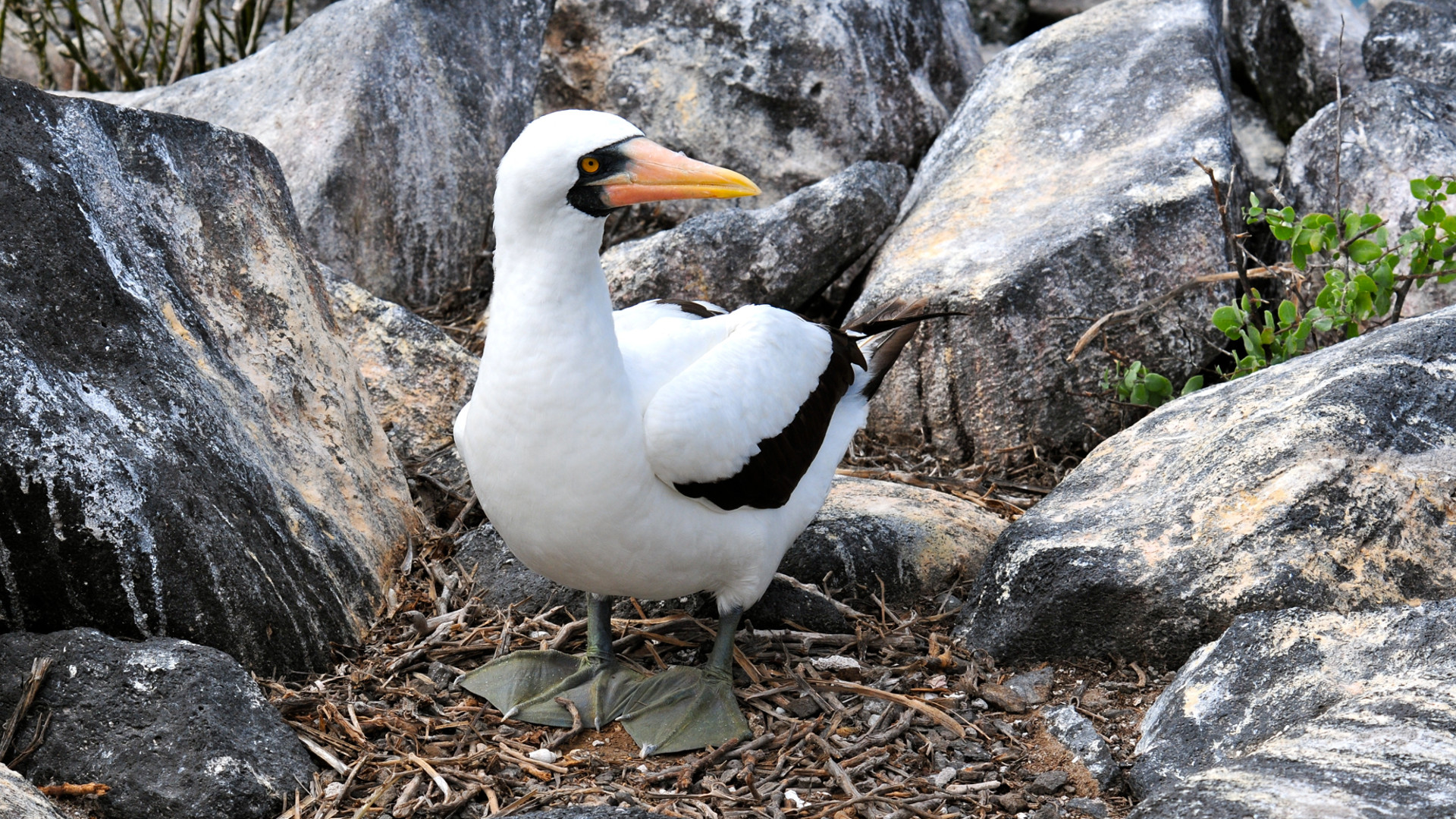One of the most famous bird species in the Galápagos Islands faces a potentially catastrophic shortage of nutritious food, and climate change may be to blame.
News of this nutritional deficiency, which is affecting Nazca boobies (Sula granti) — the iconic bird species Charles Darwin studied before writing his groundbreaking work On the Origin of Species — comes from a new study published recently in PLOS One. The study makes a rare connection between ocean warming and species population effects in the tropics.
“All the data suggests that they are struggling to find food,” says Emily Tompkins, a Ph.D. student at Wake Forest University and lead author of the study, who started fieldwork in 2010. “Not only are they getting a lower quality prey, but we’re also seeing that they’re coming back with fewer fish, or more often than not, no fish at all.”
Tompkins joined an ongoing study that has been observing the species for decades. After 30 years of logging data on the birds’ diet, breeding and survivability, researchers on Isla Española found evidence of a shrinking population. Within the past decade the boobies’ reproductive success, which is defined as the probability of producing an independent offspring, fell by approximately 50 percent. Why? Because the warmer waters surrounding the islands became intolerable for their main prey, the sardine (Sardina pilchardus), which can only live in waters measuring between 14 degrees Celsius and 20 degrees Celsius.
“Nazca boobies are top predators, their diet composition is simple, and loss of their sardine prey is catastrophic,” the study’s conclusion reads.
To compensate for the scarcity, Tompkins says, Nazca boobies started switching their primary diet in 1997 to flying fish (several species from the genus Exocoetidae), which are basically junk food compared to the nutrient- and lipid-rich sardine. Scientists found that chicks raised primarily on the flying fish had a slower growth rate, and their survivability declined.
What happened to the sardines is still a mystery. Some populations may have died off, while some may have moved closer to the poles. Tompkins thinks their disappearance might have something to do with oceanographic variables like the Pacific Decadal Oscillation, a recurring pattern of warm and cool water-temperature phases that cycle every 20-30 years. That pattern has long seemed to be correlated with abundance in sardine populations, although there isn’t any concrete data to back it up.
“We don’t know for sure what happened to the sardines,” says Tompkins. “Studying pelagic populations of fish [which live neither close to the bottom of the ocean or near the shore] is much harder,” than studying marine birds, she points out.
Regardless of where the sardines went, the study does conclude that if the waters around the Galápagos warm at the rate scientists have forecasted (up by 4.5 degrees Celsius), the sardines will be completely absent from those waters within 100 years. This has implications not only for Nazca boobies but for other species that rely on them as a primary food source, including blue-footed boobies (S. nebouxii) and Galápagos sea lions (Zalophus wollebaeki).
“If the current links that we’ve uncovered right now in the last decade continue to hold in the future, and if sardines are absent in the Galápagos, the data that we have, which comes from really fine-scale observations of individual reproductive success and survival suggest that the population will decline,” says Tompkins. “Much of the success of these birds is dependent on their food source.”
This study represents a rare look at the effects of climate change in the tropics, which are famed for being cradles of endemism and fountains of biodiversity. David Anderson a professor of biology at Wake Forest University considers this study — which he co-authored — significant because “few connections have been made between ocean warming and population effects in tropics.” He says the poor prognosis for the Nazca boobies may apply to other predator species in the region which will also face stiff challenges adjusting to rapid climate change in the tropics due to their typically long generation times and little capacity for adaptive evolution.
“We can expect similar consequences for food webs everywhere under climate change, with unfamiliar combinations of predators and prey being thrown together by the changes in habitat,” says Anderson.
© 2017 Francis Flisiuk. All rights reserved.
Previously in The Revelator:
Lobsters in Hot Water: Climate Change Threatens Maine’s Most Valuable Fishery



It’s more like it is overfishing than climate that is the reason.
I have to disagree about your theory that overfishing is the problem Heraklit . The good news is that during these cold Humboldt current months of July – December the ocean near Galagagos Archipelago is teaming with sardines. If we can’t “save” Galagagos islands from Climate Change – what is our fate as a Planet?
The collapse of seabird populations is global not just the Galapagos. The single common cause is NOT the catch all usual suspect “Climate Change.’ The common cause is collapse of primary ocean pasture productivity, read this as collapse of plankton blooms. The cause of this collapse is not ocean warming, that is one of the results of ocean pasture collapse! Ocean pastures are collapsing due to the potent forcing role that CO2 has in greening the Earth, greener earth as seen in more grass growing on lands has resulted in less dust blowing from the land. It is the dustfall that originates from lands that nourishes and sustains ocean pastures. This is the other side of rain that falls that nourishes and sustains green pastures on land. Everyone knows that pastures without grass, or plankton, can sustain no livestock or in this case seabirds. The incessant drum beat to the single ‘climate change march’ distracts and misinforms people from the more immediate crisis of high and rising CO2 that is resulting in starving oceans. Here’s more http://russgeorge.net/2017/10/21/plankton-pastures-are-the-most-important-ecosystems-powered-by-the-sun-they-control-our-climate/